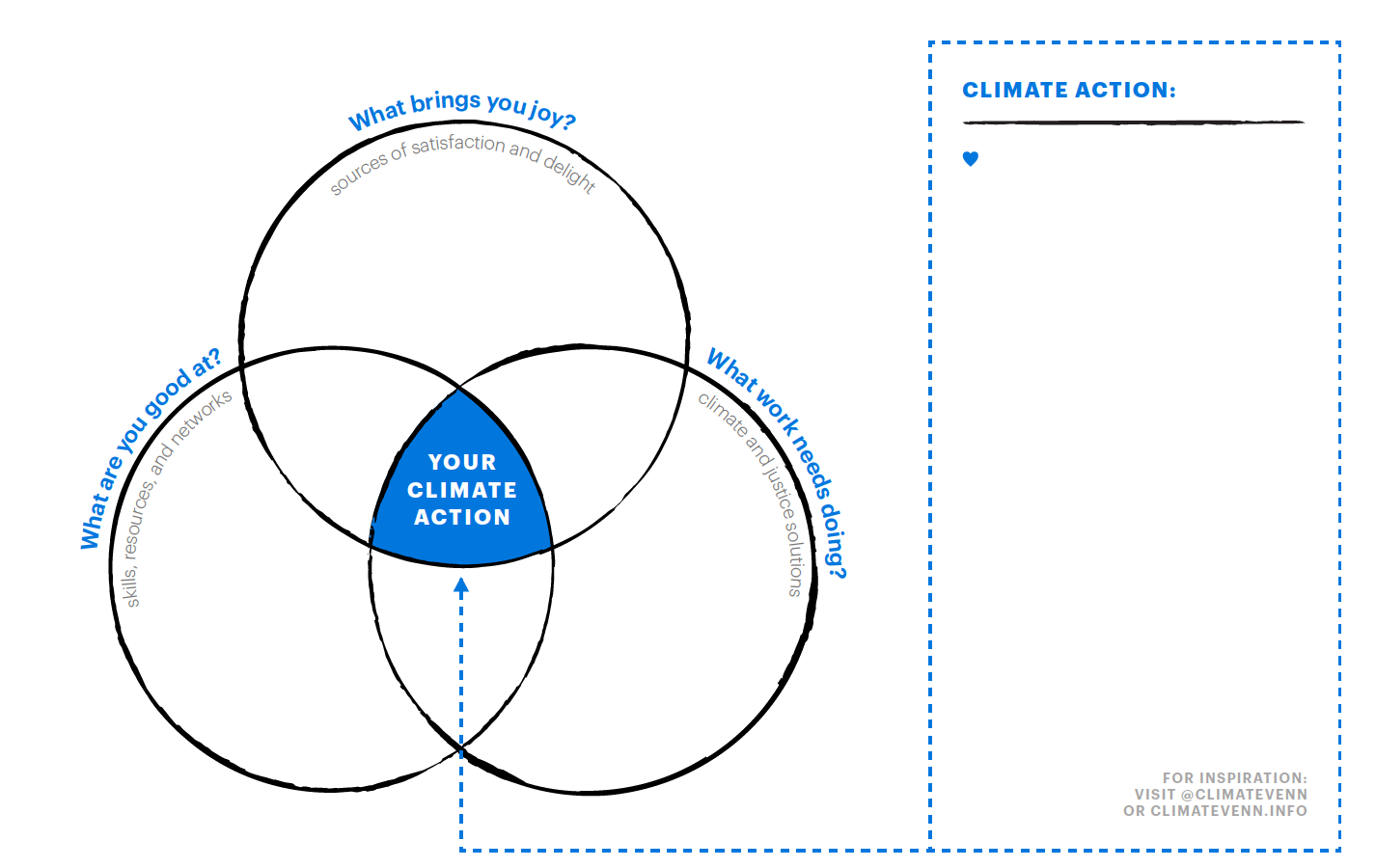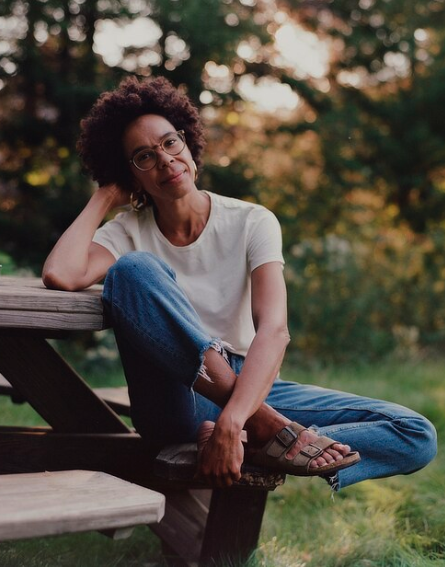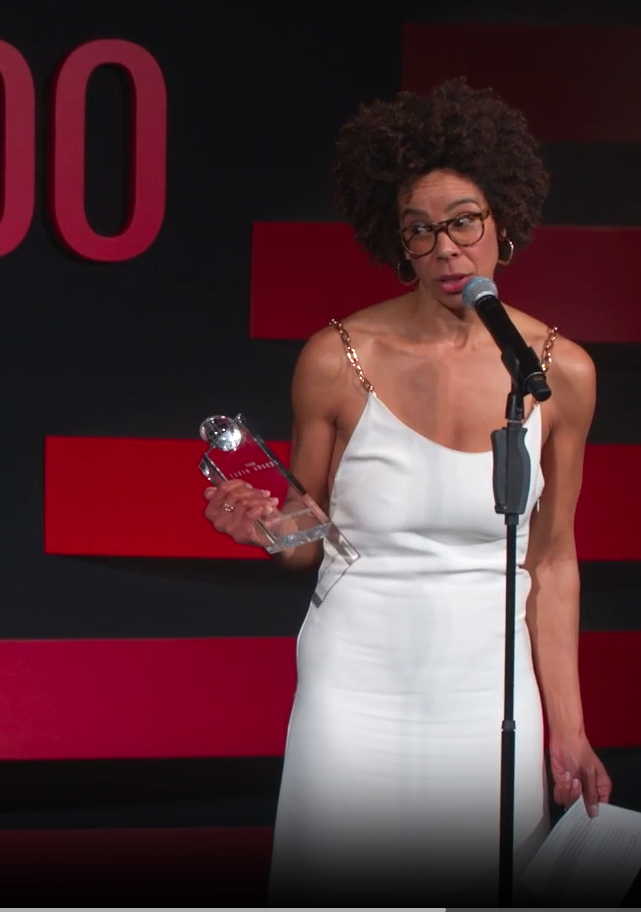Back to the Future: Olalekan Jeyifous's photo-montages in the Proto-Farm Communities of Upstate New York series envision a back-to-the future where emerging climate science in the 1980s informed protopian communities in the 1990s.
Shown above: “Brooklyn Depot” from the series. With a terminus in Brooklyn, the Proto-Farm Communities use advanced green technologies to produce food, seeds and freshwater. They are located in an alternative economy with market-based mobility credits to combat climate change. The series was created for the "Climate Futurism" project curated by Ayana Elizabeth Johnson as part of her What If We Get It Right? Visions of Climate Futures compendium.
Olalekan Jeyifous developed a futuristic environmentalist artistry before the emergence of commercial AI generated imagery.
Cover image: Elizabeth Ayana Johnson’s 2019 TED Talk: A Love Story for the Coral Reef Crisis” Photo: Ryan Lash
Reimagining the world
by finding your own specialized and even joyful place in climate solutions
Ayana Elizabeth Johnson’s What If We Get It Right? is a wonky yet creative, worldly yet Brooklynite-to-the-bone, formal yet freestyle invitation to envision a thriving climate future. These visions emerge as we figure out the self-fulfilling, self-motivating roles we can play in realizing them.
Most Americans favor climate action but are unsure how to do much more than properly recycle, and even that can get muddled. Johnson encourages readers to find their own climate action niche, including by filling in a personalized Venn chart.
Being both a marine biologist and an environmental policy expert, Ayana Elizabeth Johnson is uniquely qualified to tackle the climate solutions topic. Through essays, interviews and personal reflections, she demonstrates that we already have the scientific knowledge and technologies to implement climate solutions. What we too often lack is the collective will, coordinated action, and, most vitally, the enthusiasm to walk the talk.
Johnson’s climate strategy shifts from simply focusing on mitigating disaster to actively creating a better world by imagining what we’re good at and what brings us joy.
But her first order of business in the book is to establish the personal context. She states, “I thought I should introduce myself and reveal my predilections toward wonder and joy and saltiness and loving the world.” Using the uppercase style for Black and White, she identifies her overall social identity as both simultaneously “Black” (Jamaican-born father, now deceased, who was an architect and potter) and “White” (American mother, a secondary school English teacher who now lives on a small homestead farm in Upstate New York). She refers to her childhood self as “this little Black girl in Brooklyn.” The “saltiness” in Johnson’s self-description seems to stem from being “an inner city kid,” and is also a apt allusion to the salt water oceans that she studies. Born in 1980, this “inner city kid” was in the first generation to grow up entirely in the hip hop age that was also when the term “nerd” emerged into popular American speech.
So when Johnson was hosting her What If We Get it Right podcast (transcriptions from which form the core of the print book), she was like a freestyle rap nerd diving into the weeds of clean-energy financing and the finer points of Green New Deal policy. Looking for the clear-cut strategy, she would think, “Fuck hope,” and, with regard to can over hope say, “This shit ain’t over yet.”
A salty literary nerd, as well, Johnson knew where to look to find the great writers, poets, lyricists and community voices to be in her Amen Corner. Separating the sections of her book are free-standing galvanizing sayings by Arundhati Roy (“What lies ahead? Reimagining the World. Only that”), Wendell Berry, Maya Angelou, Audre Lorde, Pete Seeger, Lauryn Hill, Jacqueline Woodson, adrienne maree brown, Toni Morrison, James Baldwin, Marge Piercy, Grace Lee Boggs (“We must transform ourselves to transform the world”) and others.
Once she clarifies the racial identities, Johnson broaches the dreaded “doom” aspect of the current climate situation before getting the joy back on.
The climate prospects are horrendous
The Earth is hotter now than ever, primarily due to the vast amounts of greenhouse gases of our own making. And it’s not just the atmospheric heat of climate change that should concern us, says Johnson. The ocean has absorbed most of the heat, leading to extreme water events.
Glaciers are melting, sea level rising. Humans are also altering the chemistry of the world's oceans causing acidification, so marine organisms are struggling to build shells and skeletons.
Simultaneously, human rapacity is causing deforestation, which also accelerates climate change and radically reduces biodiversity, threatening a million species.
Also there’s all of the plastic pollution. Plastic is now found in the ocean at a level that’s on track to outweigh fish, unless we act now. We even become polluted ourselves from microplastics and chemicals in drinking water, human blood, breast milk, and clouds.
This pervasive pollution of the planet is further leading to ecological breakdown, including the disruption of food webs due to early spring arrival and the disruption of the cycles of plant and animal life.
The doomsday beat goes on and on and ominously on: excessive consumerism, sprawling development, toxic agricultural and industrial runoffs, massive food waste on one end and on the other end: increasing famine, scarcity breeding, conflict, and the spread of disease.
And from the justice perspective, Johnson points out that vulnerable communities, who contributed the least to the environmental crisis, are hit first and worst.
Humanity can at least survive if we don’t get it right … right?
After the reality check, Johnson joins Columbia University astrophysicist Kate Marvel for the exhalation with the upshot being that humans can survive (but barely) the Earth’s degraded environment if the planet continues reaches two degrees higher.
Columbia University scientist Kate Marvel designs climate models from interpretations of Earth data informed by physics and chemistry. Based on analyzing lots of minutiae from many sources including historical data, she makes ongoing assessments of the rates and degrees of climate change and its current and potential impacts.
According to climate warming science and the Paris Agreement, the goal is to limit the increase in the global average temperature to well below two degrees Celsius (°C) above pre-industrial levels, while "pursuing efforts to limit the temperature increase to 1.5°C".
While Kate Marvel has concerns about this goal, she says that doomsday would not immediately occur if average temps rose by a full two degrees. In the short term, life on the planet warming to this extent would be untenable (uncomfortable and particularly worse for people who did nothing to cause the warming) but not extinct. The point was to emphasize that we should not feel overwhelmed and paralyzed by increasing climate warming. Still complacency would be disastrous.
Marvel’s assessment on Johnson’s podcast was made when it would have been almost impossible for many people in the U.S. to conceive of the massive assaults on the world’s environment by the second Trump administration. The assessments must be much more dire now. To stay stay abreast of current developments, I subscribe to Johnson’s free newsletter .
Marvel pointed out an engineering aspect that most people don’t know about: the need for new transmission lines because renewable sources of energy will need “a different structure than the current electricity grid where we just burn stuff.”
I’m noticing related developments like this energy post in my email about making electricity cheaper for renewables and wonder if Kate Marvel means we’ll need new transmission lines to connect hydropower plants (turbines that generate electricity from water, not ‘burning stuff’) to users of renewable sources of energy. Maybe it’s a naive thought but at least Ayana & Company are getting me “hooked” to the point that I’m asking dumb questions.
After reading Johnson’s autobiographical essay, I listened to the rest on Audible. In the print version, Johnson embeds animated conversations with text data full of asterisks, internal exclamation points (denoting key concerns), underlines (forward way pointers) and heart symbols (poignant points). There are end notes, listings of problems and possibilities, and enumerated policy recommendations. All this detail begs for further reference so the print book becomes a well-organized resource to which I often refer; not a continuous read from front to back.
One of the listings speaks directly to the reader, suggesting how the most bewildered can leap into action; for example, this point from the list: “4. Find Your People … “My people are conjurers,” says Johnson. “They don’t stop at dreaming, they make something where there was nothing, something needed. They make magic in the real world… .” So dear reader, find your magical connections in the real world where you live.
An unstoppable dreamer and conjurer herself, Johnson also has a strong grasp of policy matters. She contemplated being an attorney who develops, regulates and litigates environmental policy. But fieldwork in, and near, the ocean, was the stronger lure. After a BA from Harvard University in environmental science and public policy, she earned a Ph.D. in marine biology from Scripps Institution of Oceanography.
Listening to What If We Get It Right on Audible in the morning or evening as I bustled around in the kitchen was addicting. The dense granularity of the scientific and policy data was easily assimilated when doing mindless housework like saving water from rinsing produce and dishes to use for watering the plants. With its various disciplines trained on interacting layers from the ocean depths to “the pale blue dot,” the climate science discussion is riveting in its range and possibilities.
From policy to rom coms
Johnson was very animated when chatting up her college (Harvard) chum, Franklin Leonard and prolific screenwriter, producer, and director Adam McKay. Leonard compiles the “Black List” of screenplays worthy of production. Whereas the original Hollywood blacklisting of the 1950s was a "red list" of suspected communist sympathizers, Leonard's Black List is one of inclusion, opportunity … and excellence. McKay wrote and directed “Don’t Look Up,” that widely watched satirical film about denial, posturing and paralytic responses to the looming threat of climate catastrophe disguised as a killa asteroid heading towards Earth.
Leonard, McKay and Johnson grappled with why the storytelling conventions and financial priorities of the big film studios don’t seem conducive to making movies that dramatize climate change, or even have climate-related side plots. But they concluded that studio executives are not dolts: they could appreciate the urgency of, as Leonard puts, the “most important issue confronting humanity” and how that can generate compelling plots and good box office sales. So writers need to get busy on creating cli sci, cli drama and cli rom com screenplays that are entertaining page-turners with at least one character that the execs won’t want to part with at the end.
When Johnson emphasized that she’d love to see climate solutions romantic comedies and suggested some scenarios, I immediately thought about a rom com character based on a woman of color like Johnson herself: quirky, bespectacled, hair happily going bonkers, brilliant, unconventional and down as she is nerdy. When will we see a black woman protagonist like that in a movie? Long past due! Such sistas are not anomalies.
The big take-away from listening to this media conversation was reflected in what seemed to be characters, gamers, larger-than-life but unstable figures like Trump and Musk appearing to treat all that they have dominion over as the ultimate high stakes game, not the conscientious, sacred even, responsibility that comes with power and privilege.
But on the other hand, when wonk is woke …
According to some wisdom traditions, we’re all characters playing roles until we awaken to the undivided witness that we all fundamentally are. Given this perspective, Johnson and the people she engages in the book are on their way to awakening if not already woke.
The What If We Get It Right cast is stellar: Bren Smith, regenerative ocean farmer; Judith D. Schwartz, environmental journalist; Leah Penniman, farmer and organizer; Brian Donahue farmer/forester and historian; Kate Orff, landscape architect; Bryan C. Lee Jr., design justice innovator; Paola Antonelli, museum curator; Mustafa Suleyman, artificial intelligence pioneer; Bill McKibben, climate investment mobilizer; Régine Clément, sustainability solutions entrepreneur; Jigar Shah, clean-energy financier; Corley Kenna, corporate executive; Kendra Pierre-Louis, journalist; Xiye Bastida and Ayisha Siddiqa, youth environmental activists; Kelly Sims Gallagher, international policy expert; Rhiana Gunn-Wright, architect; Abigail Dillen, disasterologist; Samantha Montano, attorney; Colette Pichon Battle, climate justice leader; Jade Begay, Indigenous political/cultural strategist; Oana Stănescu, architect-philosopher, in addition to the people named in the previous sections of this column.
Heaven on Earth
The book ends in a rapture: Ayana Elizabeth Johnson’s grand vision for how the world would be if we do get it right. While spectacularly grand, the vision is rooted in tradition. There’s basically nothing new about ecological restoration, clean energy, resilient local economies, robust, equitable governance. And a thriving natural world is what we were given from the start.
A vision of the old that’s very — that seems futuristic — but already here but only in scattered communities around the world.
Hearing Johnson, in her own voice, describe the vision on Audible sounded like heaven on earth.
If we get it right, ecosystems are healed and the Land Back movement empowers Indigenous peoples to steward ancestral lands. Food systems have fundamentally shifted: regenerative agroecologies replace toxic Big Ag. Coastal areas are protected by replanted green infrastructure.The combustion phase of humanity is over. Cities are transformed by free, extensive public transit (a system already being realized in the Netherlands and a key plank of Zohran Mamdani’s platform, who, at this writing, has just been elected mayor of NYC). Carpenters and plumbers become prestigious. Humanitarian migration supports people moving away from uninhabitable areas. The economy prioritizes circular exchanges and over capital accumulation. A single, thriving wage can support a family, a universal basic income … and more. The rapture goes miraculously yet conceivably on, with ‘getting it right’ for the planet cascading into positively transforming the ways we all live.
By the end, all I could do was gasp at the Got It Right panorama: so grand yet so real, so far yet so close… .
J.H.
Biophilia
“What brings you joy?” is at the top of Johnson’s climate action Venn chart.
One inspiration for the chart is biologist E.O. Wilson who advanced the term “biophilia.” This concept, meaning the innate human connection to nature, serves as the emotional foundation for the Venn chart, suggesting that our most effective climate action will naturally align with what we are inherently drawn to project and protect.
The Venn chart and worksheet can be downloaded from here. A video with tips for filling out the work sheet is linked to that page.
Elizabeth Ayana Johnson
Climate scientist Kate Marvel.
Fitting surname, given the prodigious character of her work!
Photo from Marvel’s Wikipedia page
Impassioned acts of creation in response to environmental crises
Elizabeth Ayana Johnson exhorts us to devise climate actions driven by personal passions. An example of such motivating force is the response by Nigerian authors to the series of record-breaking floods in Nigeria in recent years.
Osahon Ize-Iyamu’s short story "More Sea than Tar" (2019) dramatizes a Nigerian family overwhelmed by floods and rising waters.
Suyi Davies Okungbowa’s “cli sci” novel Lost Ark Dreaming is set in off-shore Nigeria after a climate catastrophe called “the Second Deluge.” The rising Atlantic Ocean deluge drowned Lagos and surrounding coastal areas. Survivors live in The Pinnacle, the sole remaining structure of a five-tower complex called "The Fingers." This high tower was originally built offshore as a luxury development for the wealthy to escape the chaos, pollution, and rising waters. But now it’s a massive, partially submerged ark for humanity.
News
On October 30, 2025, Ayana Elizabeth Johnson was honored as one of Time magazine's "TIME100 Next" leaders.
During her acceptance speech, Johnson said, "It took me way too long to realize that cultural change usually comes before policy change." Listen to her full speech here.
Unity, the spirit of community
This framed handwriting hangs on Elizabeth Ayana Johnson’s living room wall.
Detail of photo by Landon Speers







